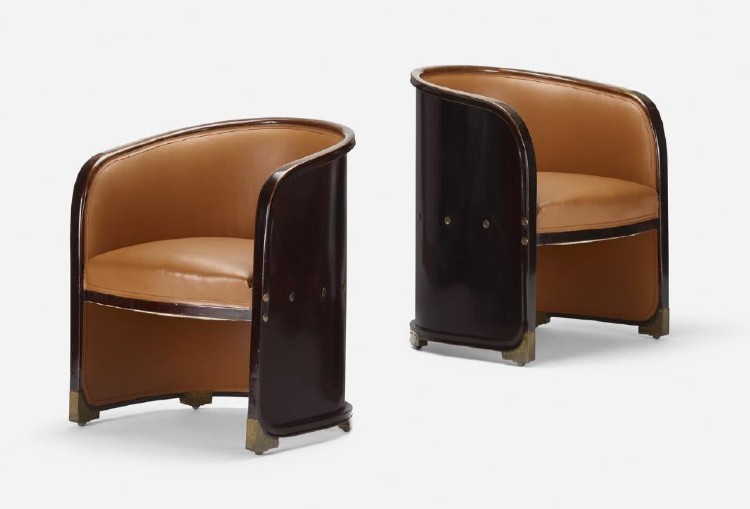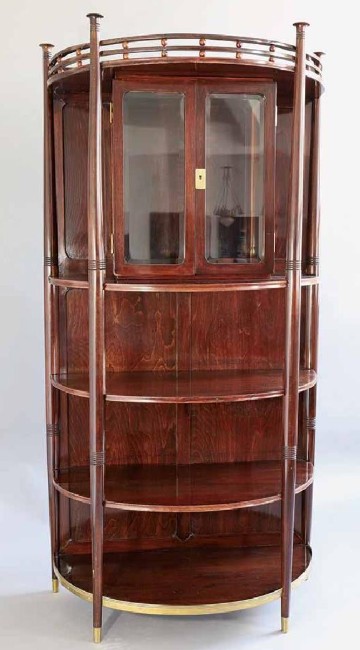
NEW YORK – Josef Hoffmann and his fellow artists/designers of the Wiener Werkstätte in Vienna in the early 1900s sought to eliminate the distinctions between art and design. As co-founder of the renowned workshop, Hoffmann has created an impressive body of work that embodies fine design with objects that stand the test of time. Even as styles change and fashions go in and out of vogue, Hoffmann’s works are timeless. No wonder he has been dubbed the father of modernist architecture and design.
Running the gamut from furniture, carpets and lighting to silver, vases, small accessories and dining wares, Hoffmann (1870-1956) created objects that rely on design instead of superfluous ornamentation to be beautiful and visually striking.
Both private collectors and public institutions have long been taken with Hoffmann’s work. Even in his early days with the Vienna Secessionist movement, his work was revolutionary.

Introduced on a global scale at the 1900 Paris Universal Exposition, Hoffmann began shifting his style, favoring geometry and avoiding excess ornament in his designs.
A silver “Gitterwerk” basket from 1905 in the collection of the Milwaukee Art Museum evinces this aesthetic. “The basket’s elegant gridwork is an excellent example of how Hoffmann created visual interest through an object’s structure, rather than by adding additional ornamentation,” according to a museum blog. A nearly identical “Gitterwerk” basket sold for $75,000 + the buyer’s premium at Phillips in March 2011 and remains the highest sold price for a work by Hoffman in LiveAuctioneers’ database. Perforated bread baskets he created having a repeating ivy pattern (“Efeu gebuckelt”) also remain popular today.
Original Hoffmann designs, especially commissioned pieces made for affluent clients pre-World War I, are quite desirable today. An important trio of lighting fixtures commissioned circa 1906 by Dr. Hermann Wittgenstein in Vienna, made of hammered and silvered brass with glass shades, holds the auction record for the designer at $774,000 + the buyer’s premium, when it sold at Christie’s New York in December 2020.

Furniture and lamps routinely bring big prices at auction – usually around $50,000 to $100,000 – with even higher prices sometimes seen for one-off pieces having strong provenance, such as an important pine and sheet metal cupboard made for the Alfred Roller apartment, Vienna. The circa 1906 piece sold in the aforementioned Phillips auction for $70,000 + the buyer’s premium. “The square, the grid, the framed plane restrict space but when repeated suggest endless recurrence and limitless space,” according to Phillips’ description of the cupboard.
Hoffman himself noted at the time that his penchant for using circles and squares in his designs was because they had not been previously conceived of in this fashion. In moving away from the flourish and curves of the Art Nouveau era into the more streamlined Art Deco period, Hoffman was ahead of his time.

Even small items such as elegant hair combs designed by Hoffmann perform well, such as one made with gilt silver, mother of pearl, cultured pearls and tortoiseshell in 1909 that achieved $38,000 + the buyer’s premium in February 2020 at Rago Arts and Auction Center. Hoffman’s jewelry designs also command collector interest and show his evolution in style from a circa 1912 women’s ring with gold and pearls that has an Art Nouveau feel to a later silver, malachite and turquoise brooch that is more geometric.

Among his furniture designs, his cabinets and chairs are widely celebrated. Pieces such as his Kubus armchairs in leather (designed in 1910) have been widely reproduced over the decades, keeping to Hoffmann’s original specifications.
Interestingly, Hoffmann is most remembered for his designs but his work as an architect in his later years is where he hoped to pin his legacy, considering himself an architect first. Receiving his first building design commission of the Palais Stoclet in Brussels in 1905, he went on to design exhibition buildings and several important private homes as well as residential and commercial interiors throughout his life.
His tireless inventiveness and forward-thinking designs of artful objects continue to appeal to buyers today and they seem as fresh as the day they were executed in his workshop. Blurring the lines between what is art and what is design, Josef Hoffman broke from the traditions of his day to create a new modernity aesthetic. In doing so, his modern designs have become tradition.


